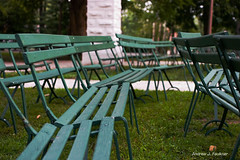Study Abroad as missed opportunity!?
Study abroad programs have become a major industry for higher education yet in architecture they often function somewhat paradoxically. Ideally the purpose of such study is complete cultural immersion and appreciation for other approaches to universal problems as well as invaluable personal experience with works of architecture. This perhaps is key as the subtle characterization of light and space in three dimensions is virtually impossible to fully comprehend through representations alone. I would argue that the cultural understanding and immersion is just as crucial to understand how in the context of the built architecture. The paradox of study abroad is that it tends to take two forms which are counter to some or all of the goals of foreign study.
First, study abroad tends to easily become corrupted by the virulent architectural studio culture leading to sequestration of students inside studio rather than outside among the architecture and the culture. One example of this would be a prominent architecture school [name redacted but they will be playing in the Rose Bowl this year] who houses students for its Florence study program in a villa over 40 km from Firenze. One can logically question, given the distance, just how often the students will ever reach their alleged object of study.
The second type of study program is the whirlwind study tour (ie If It's Tuesday, this Must be Belgium). While very strong experientially such programs utterly fail at cultural immersion and understanding and often end up as a surreal blur of architecture fueled by lack of sleep, disorientation and booze.
Then there is the question of whether study abroad programs are becoming increasingly irrelevant in the face of global forces.
I was privileged enough to spend about 12 weeks studying in Italy three years ago and was startled to realize (although it shouldn't have been much of a surprise) that the phenomena we studied in the greatest depth were unnervingly similar to problems faced back home. For two weeks we studied the sprawling "Adriatic City" a loose conglomeration of big box stores, warehouses, housing tracts (with cul-de-sacs even!) and apartment buildings that sprawls across the Adriatic plane over half the length of the coast. This area is characterized by shoddy speculative building, heavy industry,automobile dominance, and wall sized supergraphics that would make Morphosis proud. Obviously these are resultant from truck-based shipping, the highway network needed to facilitate it, and the speed at which the observer moves relative to the context; all of these have as much to do with Italian history and culture as sushi does.
After this project the subject for my independent study became abandonment and, while dealing with historical examples of abandonment and ruin, I found the project focusing more on contemporary examples of abandonment from shuttered gas stations to abandoned tourist motels to industrial relic that were, to my view, suprisingly littering Italy often almost in view of the throngs of tourists. With a step back it is clear that such sheer disposability of the built environment is certainly not limited to Italy; as a continuation of the project I extended it to the United States and used it as the basis for my senior thesis project. Much like the sprawling environment of the "Adriatic City", abandonment is a symptom of global processes that supersede natural and cultural boundaries.
Given that the major forces shaping Architecture are globalized and transnational in their effect, is it necessary to pack up and move to China to learn about rampant development and environmental un-sustainibility (or for that matter how to fight such proclivities and forces)? I argue that my talents are better used here. If a casual jaunt through the North Side, Alton, Brooklyn, or Sauget is any indication there is a surfeit of work to be done...
Notes from St. Louis: Winter Night on Skinker
My mind is still on this tack a minute later when I must divert in the street to walk around a militarily anti-urban crabapple tree which has claimed the sidewalk with its lower branches. It is Skinker at night however so I am in no danger of traffic.
As I near the crass glare of the taco and chicken stacks a pungent aroma assaults my nostrils, that of a cigarello. Looking around to see if anyone is blatantly getting blunted in the parking lot, my gaze is caught by motion on the other side of the street.
Under the full moon a stray dog is making his way north on the sidewalk. We exchange quick guilty glances, each one wondering what the hell the other is doing out on this icy night.
I leave Skinker and shuffle my way on the ice towards my warm home.
Don't expect to hear much more from me this week... Studio Final has come calling...
Playgrounds for the Lawrence Welk Set?
That being stated I have some major reservations about this kind of application. The logic being used to justify such a segregated space is bluntly put:
“Retired people need a space to be themselves without someone coming along and spilling ice-cream on their trousers or breakdancing,” said Andrea Weber, a social worker specialising in the lifestyle of the elderly. “They need to feel safe.”
While I understand that, in most cases, the aging process leads to a lack of flexibility and increased apprehension of danger (some might term that wisdom) I do not believe that it is healthy as a society to create a safe place for our elders by separating them from "our" public spaces. Ironically, by creating public space that effectively ‘wharehouses’ seniors, one might actually be creating the potential for much more crime given the alarming rates at which seniors are preyed upon.
To take another tack, I might guess that a majority of our population remembers fond interactions with senior citizens in our youth. My father still remembers fondly (by name even) the old italian guys that lived in his building and on his block half a century ago. If we consider such classic public spaces as Washington Square in New York we encounter a mix of demographics ranging from the elderly talking or playing chess to the young splashing in fountains and chasing pigeons. I am not a psychologist or sociologist by any means, but I will argue that such intergenerational and cross-demographic contact both helps social cohesiveness and fosters responsibility to others in society. Finally, I have noticed that when seniors get very old (beyond the point of any sustained exertion) they often find great comfort in simply observing life around them. Shortly before my grandfather died from heart failure he would find what appeared to be great pleasure simply sitting on the couch and watching three generations of his family swirl around him. Although I cannot put myself in his place, I can understand how gratifying that might be after almost a century of life.
If places for senior citizen recreation are designed as discreet nodes I feel it is this connection that will be lost. After all, after many decades of life would you rather spend your time with your extended family and friends or with those who coincidentally were born around the same time you were?
this made my night!
Alexandre Orion: Subversive Commentary Through Erasure

These images, with iconography seemingly derived from both comic book and Panamerican cultural traditions serve to question the toll of our dependancy on petroleum and other (and far more hazardous) chemicals. As the artist notes: "‘Cleaning’ is not a crime. What is a crime is the environmental damage caused by unashamed pollution." Interestingly, such an intervention is only possible as a result of the grime generated by the exact wasteful processes that they are critiquing. Therefore, the critical response becomes subversively part of the system it questions. As such the ultimate goal of this expression is to prevent its own existence by erasing the cause of its media (the grime caused by the abuse of the environment); this I feel has the capability to render it almost incorruptible by commodification. Although, given the way things have been shamelessly going, I wouldn't be surprised to see BP erasing ads out of the grime caused by their oil plumes. Anyway, back to the art:
As Professor José de Souza Martins of the University of São Paulo reflects:
"These images speak to us of love and hate. Love for the city we live in, love for the city we could have, love for an urban utopia that belongs to everybody not just for a few; love for those inhabiting the city who take it to heart and make it part of their own consciousness... Hate, because the city is being consumed in a predatory manner by... those who think they are smart because they appropriate that which does not belong to them."

Refreshment

Refreshment
It was tricky to work the macro lens and the foot pump for the fountain at the same time while staying in focus... I'm sure passersby thought I was crazy
Originally uploaded by postmodern sleaze.
Delineation
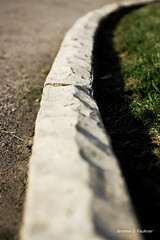
Delineation
The park on the whole reminds me of a book I treasured as a child: The Park Book. The only thing missing is the low ornamental iron borders around the paths. However, these beautiful limestone curbs may even be better...
Originally uploaded by postmodern sleaze.
In Training...

In Training...
I wondered why such a nice bike was so neatly abandoned in the middle of the park. I later discovered a young boy and his father sitting on the steps on the other side of a gazebo.
Originally uploaded by postmodern sleaze.
Processional
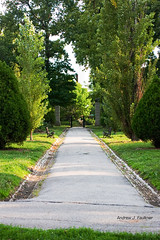
Processional
Despite the beauty of the afternoon the hour grows late and I must depart... damn good to because I hit a torrential thunderstorm in my car about 10 minutes later!
Originally uploaded by postmodern sleaze.
I know I promised to blog architecture next but...

Well, that's where the situation becomes interesting. The developers of the property, a massive and long-abandoned horse stables turned icehouse, have joined forces with the Wooster Collective to have internationally famous street artists decorate the facade, culminating in a huge party in December

ABOVE
londonpolice
and
Michael DeFeo
have so far contributed works and one can only imagine who will drop by next. As the Wooster Collective website
notes:
"Watch this space - literally.
If you're an artist who we've featured on the Wooster website in the last 5 years and you're coming through Manhattan in the next six week, drop us a note.
And if you're in New York, don't make any plans for the second week in December ;)"
As "D" summarizes in his comments at Gothamist:
"There's a big vacant building on which people started to put up unauthorized art (or whatever), the owners responded by saying, "hey, let's get an artists' collective to curate the way the building is decorated so it has some cohesiveness and flow (and so that some established artists are inspired to contribute), the artists agree to abide by a deadline, it's all free (!!), there's gonna be a big party at the end, and everyone gets along?? No divisiveness? No bitterness? No unreasonable squattters [sic] demanding to stay rent free or artists demanding that the art be preserved forever? No black-hearted landlords crushing the art with wrecking balls?
No government intervention or regulation?
this is too good to be true."
I believe the art will be removed during the renovation next year, but given the temporal nature of the form I believe this offers a wonderful paradigm for cities with numerous abandoned buildings and buildings stuck "in progress." Here in St. Louis Chivvis Development did something similar (albeit with artists of much less renown) on several buildings it owns at Chouteaus Landing on S. Fourth. I think such "legal walls" offer an opportunity to enhance the visual density of the city, celebrate diversity, and at least partially redeem the gaps (or more specifically dents I suppose) left in the urban fabric by abandonments.
Here's to hoping we see much more of this phenomena both locally and nationally!
It's Morning Again in America
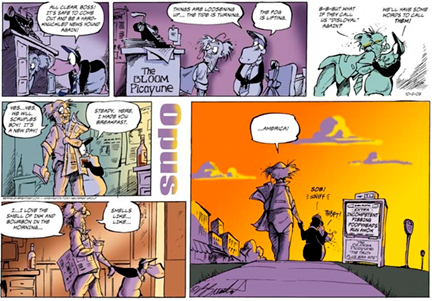
However, the battle is still far from over; Robert M. Gates who will replace Donald Rumsfeld as Secretary of Defense has a bit of history in the particular region we find ourselves currently embroiled in. Obviously I am aware that the world was a different place in the early 1980's, but the person to replace our heroically incompetent S.O.D. (nice acronym!) should be cut of different cloth rather than another official who is privy to programs of dubious legality, the flouting of international law, and assistance to our professed enemies no?
Well enough of that tack...
While I personally am far to cynical to ascribe the events of November 8th as a sea change, I do feel that, ‘throwing out the bums’, the American people have collectively repudiated the Rovian doctrine of rightist extremism and divisive discourse. Of course, the sheer number of convicted felons, gay pederasts, and suspected launderers in the halls of government surely only forced the issue. As it was pointed out on CNN last night, when one has to begin one's reelection campaign with an ad stating that "While I did regrettably cheat on my wife I never choked my mistress" surely it is an uphill battle at best. But, as so many have pointed out, the old axiom "Absolute Power Corrupts Absolutely" may well become the epithet awarded this period by generations of American History teachers to come.
However, I do not agree that the principle business of the newly minted legislators should be to immediately pursue impeachment against President Bush. While this stance might seem incongruous with my general attitudes towards government, despite his utter ineptitude President Bush has been wise enough to never spread his blend of lies and spin under oath. In fact, I may be wrong (please let me know if I am) but Bush has only been under oath twice: at both inaugurations. Without immediate perjury it could take a decade to unravel the layers of illegalities and deceit that have entrapped and perverted our country (but not in a Mark Foley way... sorry, couldn't resist!) and pursuing such a process would bring the nation to a standstill.
I am not advocating ignoring the probable crimes committed by this administration (felonious wiretapping for one) but I am advocating the beginning of a concerted effort to reverse the disastrous policies of this grim half decade, and a stringent rejection of any further policies. It is my hope that such a dramatic reversal of political course may not be an isolated event, but may be the beginning of a new progressive era in which issues of fiscal responsibility, social inequality, universal healthcare, and the just distribution of the bounty of our wonderful country may finally be addressed in an inclusive and comprehensive way.
If this is going to happen it is clear that the burden is squarely on our shoulders; we the people must advocate for such causes, intimidate our representatives by strenuously voting our social consciences. We must legislate big money out of the equation, accept responsibility for continuous governmental oversight, familiarize ourselves with the minutiae of major issues, openly debate issues in a congenial matter, and above all remember that, as shown for the third time, our vote is not only our ultimate responsibility as citizens and can singularly change the course of the nation
Now... I suppose I should write on some architecture soon...
Even In satire Gehry generates firestorm
All in all, not an obvious choice to conceive a baseball-centric development. And in point of fact, Gehry couldn't care less about the sport. In one spirited e-mail joust with DeWitt, the architect freely admits he's not enamored of the American Pastime. "Not even close," he writes. "It's such a silly sport, don't you think? I appreciate its linear nature and lack of time constraints. But I much prefer watching ice hockey."
Gehry and DeWitt do, however, agree on one thing: It's about the fans.
"Watch how the little red people exit the stadium and wend their way around the site," Gehry urges DeWitt — "the site" being the fenced-in crater he has been retained to fill. "That's more interesting to me than any game. I see The Village as an extension of these patterns, a more refined version, where baseball fans can find sustenance in a more sophisticated atmosphere.
"Baseball is fine for the so-called boys of summer," Gehry's e-mail concludes, "but what St. Louis needs is something for the men — and women — of fall, winter and spring."
Plausible? Sadly yes, at least until you throw in the addition of the International Bowling Museum and Hall of Fame, (which does call St. Louis home) the Stanley Elkin Archives and the moving of the Kiel Opera House building one-half mile east. The story which is extremely well crafted (down to the engineer enthused about moving the Kiehl and the first play that will be performed by the repertory company in their new facility) certainly revives this cynical blogger's belief in the existence of satire à la Swift. The interesting (and possibly predictable) phenomenon has been the response to said article. The Riverfront Times was quickly forced to begin the web version of the story with this rather droll note:
"The sharp stick of satire titled "A Whole New Ballgame" appears to have poked more than the sensitive underbelly of St. Louis' collective cultural inferiority complex. An attorney who represents one of the famous people whose name the story features prominently called today to inform us that as far as it concerns their client, the piece is "entirely false" and has "no basis in truth whatsoever."
Whaddaya know? The principals of a company known and admired the world over (and their general counsel!) are reading li'l ol' Riverfront Times!
They did have a smidgen of constructive criticism to offer. In legal circles, the term is retraction.
The story below is a work of satire... The entrée that emerged lampoons the posturing of Cardinals ownership and city muckamucks around Ballpark Village (a.k.a. The Crater Formerly Known As Busch Stadium). It was inspired by a kernel of truth: namely, that last month the Cardinals reminded the city that the ballclub had only agreed to commit $60 million to redevelop the now-vacant site, and that it takes a few hundred million more to build a Village. From there we pretty much made it up, from Pulitzer's machinations to Gehry's illustrations to Shannon's protestations.
We trust you get the idea.
Given this quick and litigious response, one might have to take the position that, in the eyes of publicists at least, FOG isn't quite the wunderkind he once was. I can't help but to think that if this prank was pulled a decade ago, despite the complete lack of authenticity to the story, the parties involved might not have been so quick to debunk the story but rather would have basked in the spurious glow of the Bilbao effect (much like Cheney and WMDs) before softly putting the myth to rest. I believe the ferocity with which the Pulitzer team debunked this merriment shows that the endless parade of formulaic recyclings of metal chunks and tortured structures and a few neighborhood killing monster developments has taken the shine off the king of bling. Of course, with every city stunting to grab a piece of the tourist trade, and every small town pol buying Richard Florida's tripe hook line and sinker, museums to obscure persons and art institutes without permanent collections by starchitects proliferate throughout the first world and the danger of endless self-replication becomes paramount. Are you listening Danny?
But I still like the IAC building screw ups and all...
not so quiet on the western front...
So I'm in the tail end of an intense four week design project (midreview was last Wednesday, final review is next Monday) and I've been quite busy juggling that and ordinary class obligations. Sorry about the lack of new postings, but as I'm not completely insane yet I still pick bed over blogging.
Anyway, I was working in studio yesterday when I overheard that some really young kid tried to shoot up a school nearby with an assault rifle. I peeled the superglue off my fingers and fired up (no pun intended) the ol' interweb. It turns out a 13 year old middle school student came to school dressed in a trenchcoat with a t-shirt tied around his face and pulled out a Mac-90 AK-47 Replica. He fired one shot into the ceiling, then the gun jammed (be glad it wasn't a real AK-47 I suppose) and an assistant superintendent managed to convince him to leave. The kid apparently had a fascination with Columbine.
I have to say at this point that even coming from Ohio (which regretfully passed a concealed carry law recently) I was unprepared for the level of gun mania here. In a metropark driving to visit the confluence of the Missouri and Mississippi we ran into roving bands of hunters drinking beer with rifles at ready. You can't go to a show without getting patted down first. Police officers ride in their cruisers with loaded shotguns strapped to the seat. Call me a limp-wristed eastern elitist, but I have got to believe that the fact that the boy's family OWNED an AK-47 (or replica thereof) strongly contributed to his decision to shoot up his school with an AK-47. Simple logic right? What does one own an AK-47 for? Pretty much fighting infidels, protecting yourself from the marauding armies of the UN, or conceivably mowing down armies of mutant white-tailed deer threatening your garden. I mean come on!
So I was even more interested to learn that at a late press conference our Governor Matt Blunt mentioned that a Wisconsin legislator's suggestion to arm teachers might be a good idea. So, let's get this straight: kid attempts to shoot up school for whatever reason is able to bring an AK-47 to school because his parents are gun nuts and he has easy access to guns. So let's solve that problem by introducing more guns to a school environment? I remember when I was in middle school we put glitter glue in the teachers coffee during indoor recess and she never noticed. There was that one kid who could pick the teacher's desk lock with a paper clip to get at the candy in the upper right drawer. I simply cannot believe that there will not be opportunities for children to get their hands on the teacher's gun. What happens then?
I really think it is fascinating and pretty terrifying to watch politicians attempt to place NRA votes above the safety of our future generations while maintaining the guise of conscientious responsibility.
October Site Updates
Unlike the following, this book is a fairly easy read on the topic of the role of architecture in regards to rampant capitalism. Should architects actively consider their work as "product" or "holistic branding" (ie sell out like Kevin Erwin Kelley) or maintain a more skeptical view of the carnival of commodification while attempting to position the concrete elements of the built environment in opposition to unchecked consumption? BONUS: Great introduction by Kenneth Frampton
I tend to read multiple books at the same time. One advantage of this is it helps me to draw serendipitous parallels between divergent texts. Another advantage is it allows me to take a mental break after running my cerebrum at a wall for a hundred pages. Like Henri LeFebvre's Urban Revolution this is one of those books. Two essays written a period apart by Negri, referring to earlier writings, many of which were written while he was in jail in Italy, (some are non-existant) this writing examines the importance of time in Marxist thought within the framework of Italian post-Marxism. Difficult enough perhaps to begin with the sheer prolixity and demanding concepts ensure that I will probably be nursing this one through New Years but I have gained some valuable insights so far... BONUS: Sexy cover that has no relation whatsoever to the thought inside!
The classic mental gymnastics of one of the most original thinkers of the past century, this collection of essays uses the paintings of the surrealist Réné Magritte to argue that, within the system of Modern thought, people falsely equate mere visual representation with reality. I find this question quite pertinent in these current times of War received by video feed and government by dubious proxy. Perhaps the scandalous antics of the present administration are just the defining culmination of modern systems of thought in action? Terrifying! BONUS: confuse the hell out of fellow passengers on the metro/bus/plane etc who are convinced that there is indeed a pipe on the cover!
I'm aware that most of you have probably read this already... we'll I haven't so cut me some slack!
Also, if there are any books you would like to recommend please leave them in the comments section as I love a new read.
In addition I added the following blogs and journals to the links bar:
A good friend from high school is riding over 3,000 miles from California to St. Augustine Florida on his bike to raise money for research into Duchenne Muscular Dystrophy. This is his blog.
Architecture (establishment) as totalitarian dystopia
“‘The two aims of the Party are to conquer the whole surface of the earth and to extinguish once and for all the possibility of independent thought.’
Orwell divides society into three segments - the Inner Circle, the Outer Circle and the Proletariat. The Inner and Outer Circles are different levels of membership of the Party. The Party is quite clearly the architectural establishment, not the RIBA as you might think. The following quotes are taken from Part 1, Chapter 7.
‘Life, if you looked about you, bore no resemblance not only to the lies that streamed out of the telescreens, but even to the ideals that the Party was trying to achieve. Great areas of it, even for a Party member, were neutral and non-political, a matter of slogging through dreary jobs, fighting for a place on the Tube... The ideal set up by the Party was something huge, terrible, and glittering - a world of steel and concrete, of monstrous machines and terrifying weapons - a nation of warriors and fanatics, marching forward in perfect unity, all thinking the same thoughts and shouting the same slogans, perpetually working, fighting...’
You can think of the proles as the general public - those who are unfettered by the brainwashing of architectural education:
‘...the Party taught that the proles were natural inferiors who must be kept in subjection, like animals, by the application of a few simple rules. In reality very little was known about the proles. It was not necessary to know much. So long as they continued to work and breed, their other activities were without importance... To keep them in control was not difficult.’
The Outer Circle are the architects and the students of architecture. They tow the Party line, not really questioning why, just happy to be members in a privileged position (last paragraph of Part2, Chapter 5):
‘In the ramifications of party doctrine she had not the faintest interest. Whenever he began to talk of the principles of Ingsoc, doublethink, the mutability of the past, and the denial of objective reality, and to use Newspeak words, she became bored and confused and said that she never paid any attention to that kind of thing... Talking to her, he realized how easy it was to present an appearance of orthodoxy while having no grasp whatever of what orthodoxy meant. In a way, the world-view of the Party imposed itself most successfully on people incapable of understanding it. They could be made to accept the most flagrant violations of reality, because they never fully grasped the enormity of what was demanded of them, and were not sufficiently interested in public events to notice what was happening. By lack of understanding they remained sane. They simply swallowed everything, and what they swallowed did them no harm, because it left no residue behind, just as a grain of corn will pass undigested through the body of a bird.’
Finally, the Inner Circle. This is where the real power lies and is composed of the starchitects, the architectural press, the RIBA (FAIA) and the architectural academics. There is an implicit agreement between this set who direct the Party.
In 1984, we learn most about the Inner Circle and its relation to the Outer Circle when the hero Winston Smith starts to read a smuggled copy of "The theory and practice of oligarchical collectivism" - the book of the Party. It's online here. I'm quoting from Chapter III - War and Peace:
‘In practice the needs of the population are always underestimated, with the result that there is a chronic shortage of half the necessities of life; but this is looked on as an advantage. It is deliberate policy to keep even the favoured groups somewhere near the brink of hardship, because a general state of scarcity increases the importance of small privileges and thus magnifies the distinction between one group and another. By the standards of the early twentieth century, even a member of the Inner Party lives an austere, laborious kind of life. Nevertheless, the few luxuries that he does enjoy his large, well-appointed flat, the better texture of his clothes, the better quality of his food and drink and tobacco, his two or three servants, his private motor-car or helicopter -- set him in a different world from a member of the Outer Party, and the members of the Outer Party have a similar advantage in comparison with the submerged masses whom we call 'the proles'’
...and...
‘War, it will be seen, accomplishes the necessary destruction, but accomplishes it in a psychologically acceptable way. In principle it would be quite simple to waste the surplus labour of the world by building temples and pyramids, by digging holes and filling them up again, or even by producing vast quantities of goods and then setting fire to them. But this would provide only the economic and not the emotional basis for a hierarchical society. What is concerned here is not the morale of masses, whose attitude is unimportant so long as they are kept steadily at work, but the morale of the Party itself. Even the humblest Party member is expected to be competent, industrious, and even intelligent within narrow limits, but it is also necessary that he should be a credulous and ignorant fanatic whose prevailing moods are fear, hatred, adulation, and orgiastic triumph. In other words it is necessary that he should have the mentality appropriate to a state of war... In his capacity as an administrator, it is often necessary for a member of the Inner Party to know that this or that item of war news is untruthful, and he may often be aware that the entire war is spurious and is either not happening or is being waged for purposes quite other than the declared ones: but such knowledge is easily neutralized by the technique of doublethink. Meanwhile no Inner Party member wavers for an instant in his mystical belief that the war is real, and that it is bound to end victoriously, with Oceania the undisputed master of the entire world.’
It is this inert orthodoxy of power and intellectual control that causes those outside the status quo to either lose faith and crumble or, otherwise, become ridiculous characters of themselves through their advocacy of their own position. I was present at a lecture recently by one of these "outsider" thinkers who was hellbent on convincing everybody that his position was the way of the future. After the lecture finally ended somewhere past the three hour mark an influential member of the audience was heard to comment "the longer he tried to convince us of his intelligence, the less I believed it." If unyielding self-advocacy becomes a parody then how is one to fight the entrenched mass of the
That is a question I may address in the future, but until then I remain open to suggestions.
Read more here:
Part I: The Party
Part II: Doublethink and Duckspeak
Part III: Hate Week, Hangings and More
On the subject of torture...
Back in 1996, a vote for the War Crimes Act, which passed both houses with overwhelming support, could have been considered a vote for the U.S. to follow the Geneva Conventions to the letter. When a House Judiciary Committee panel first considered the War Crimes Act in June 1996, John McNeil, then a senior deputy counsel at the Department of Defense, testified that the bill was "an opportunity for members of Congress to endorse the idea that the United States, as a political matter, should be seen as fully in conformity with its international obligations in this very sensitive area."
But at the time Republicans were really focused on making sure U.S. courts would be able to prosecute war crimes committed against American citizens, not by them. Inhofe took to the Senate floor that August to say the War Crimes Act would protect "our young troops" in the event "a crime is perpetrated against them."
It was unthinkable back then that it might be the United States that was systematically violating the Geneva Conventions. "There was never any hint or clue that this might be applied to us," stated Gary Solis, an expert on the law of war at Georgetown University. Elisa Massimino, Washington director of Human Rights First, explained, "No one ever questioned that the U.S. would comply with the full range of the Geneva Conventions obligations."
That is, no one doubted the U.S. would comply until early this month...
So, therefore, when being part of the international community will help protect the lives of our soldiers the Geneva Convention is our friend, but when we are busy killing our own troops through incompetence and negligence and we justify torture as being a good PR tool that will help Joe Sixpack wrongly believe that the actions of this administration (and its war on a philosophical construct) have made us safer, then it is perfectly acceptable to pull a bigger about face than Lieutenant Kerry ever perpetrated.
Torture, as so many have noted, is simply in the worst interests for our country by not only inspiring (and rightly so) hatred around the world, but by also empowering out darkest motivations:
Granted such liberty in dealing with prisoners, some officers started to enjoy themselves. They made up games, forcing prisoners to dance, smearing glue on their heads, stripping them naked, pouring frigid water over them. Sometimes guards had too much fun and a prisoner died. Then prison-appointed doctors, who often participated in the interrogations, wrote up fictive autopsy reports.
America?
No. This passage describes Soviet Gulags.
Taken from an interview in Harper's historian Kate brown notes that
Declassified FBI and U.S. Army files detailing abuses of detainees in U.S. detention centers uncannily echo Soviet NKVD reports. They recount late-night roundups of civilians and describe prisoners held in chambers of extreme heat or cold, chained naked to the floor without food and water for days on end, defecating on themselves, beaten (some to death), forced to dance, to lick their shoes and body parts, to crawl around, and to bark like dogs. American doctors and psychiatrists helped devise methods of inflicting pain and fear to elicit confessions, and they signed false reports when detainees died in custody.
Frightening.
But as Paul Rieckhoff (an infantry officer who served in Iraq) explains the new stance on terror has soldiers, well, terrified:
IN 2002, I attended the Infantry Officer Basic Course at Fort Benning, Ga. At “the Schoolhouse,” every new Army infantry officer spent six months studying the basics of his craft, including the rules of war.
I remember a seasoned senior officer explaining the importance of the Geneva Conventions. He said, “When an enemy fighter knows he’ll be treated well by United States forces if he is captured, he is more likely to give up.”
A year later on the streets of Baghdad, I saw countless insurgents surrender when faced with the prospect of a hot meal, a pack of cigarettes and air-conditioning. America’s moral integrity was the single most important weapon my platoon had on the streets of Iraq. It saved innumerable lives, encouraged cooperation with our allies and deterred Iraqis from joining the growing insurgency.
But those days are over. America’s moral standing has eroded, thanks to its flawed rationale for war and scandals like Abu Ghraib, Guantánamo and Haditha. The last thing we can afford now is to leave Article 3 of the Geneva Conventions open to reinterpretation, as President Bush proposed to do and can still do under the compromise bill that emerged last week...
But the fight over Article 3 concerns not only Al Qaeda and the war in Iraq. It also affects future wars, because when we lower the bar for the treatment of our prisoners, other countries feel justified in doing the same. Four years ago in Liberia, in an attempt to preserve his corrupt authority, President Charles Taylor adopted the Bush administration’s phrase “unlawful combatants” to describe prisoners he wished to try outside of civilian courts. Today Mr. Taylor stands before The Hague accused of war crimes.
via Adam Ash
More in the LA Times
But what do I know?
I'm just a useless architecture student not an omnipotent congressman...
...and we must be safer sine we red-stamped torture last week because today liquids have been allowed back on planes
An Open Letter Concerning Play

Sir - As professionals and academics from a range of backgrounds, we are deeply concerned at the escalating incidence of childhood depression and children’s behavioural and developmental conditions. We believe this is largely due to a lack of understanding, on the part of both politicians and the general public, of the realities and subtleties of child development.
Since children’s brains are still developing, they cannot adjust – as full-grown adults can – to the effects of ever more rapid technological and cultural change. They still need what developing human beings have always needed, including real food (as opposed to processed “junk”), real play (as opposed to sedentary, screen-based entertainment), first-hand experience of the world they live in and regular interaction with the real-life significant adults in their lives.
They also need time. In a fast-moving hyper-competitive culture, today’s children are expected to cope with an ever-earlier start to formal schoolwork and an overly academic test-driven primary curriculum. They are pushed by market forces to act and dress like mini-adults and exposed via the electronic media to material which would have been considered unsuitable for children even in the very recent past.
Our society rightly takes great pains to protect children from physical harm, but seems to have lost sight of their emotional and social needs. However, it’s now clear that the mental health of an unacceptable number of children is being unnecessarily compromised, and that this is almost certainly a key factor in the rise of substance abuse, violence and self-harm amongst our young people.
This is a complex socio-cultural problem to which there is no simple solution, but a sensible first step would be to encourage parents and policy-makers to start talking about ways of improving children’s well-being. We therefore propose as a matter of urgency that public debate be initiated on child-rearing in the 21st century this issue should be central to public policy-making in coming decades.
(emphasis added)
- Letter to the Daily Telegraph (and response here)
Perhaps it is time we not only address the welfare of our children, but also of ourselves. When is the last time you engaged in an activity not related to work, school, socialization with the opposite sex (or same for those of you who swing that way), or personal gain? Oops.. too late
It appears I'm too late on this one too
I feel that architects, especially academics and students, are at the greatest risk as we are all rallying under the same deluded masochistic banner of production; it might be curious to ask how many times did the person with the better project lose to the one who spent 86 sleepless hours working on theirs? Very rarely does this happen in my experience because the one who spent endless hours throwing together pieces of cardboard and hoping the form looks good are far less invested in their design then those who approach it from a philosophical and/or intellectual framework. Architecture is of the world and we need to experience it in its fullness so that we may adequately design for it instead of just sexing up form in the solitary confinement of our studios.
Play is immersion, training, understanding, action, and so much more that adds up to the common denominator of life.
Sunset on Collins Ave
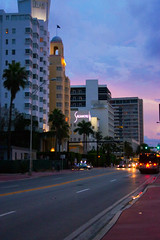
Architecture/Philosophy blog begets Photoblog:
Exquisite Struggle presents FotoFriday
Sunset on Collins Ave
Originally uploaded by postmodern sleaze.
Sunset behind the famed hotels of Miami Beach: the Delano (redesigned by Starck -- I love the original windows), the National, The Sagamore, The DiLido (closed for renovation) and the Ritz-Carlton.
Catalina

Architecture/Philosophy blog begets Photoblog:
Exquisite Struggle presents FotoFriday
Catalina
Originally uploaded by postmodern sleaze.
Courtyard Garden of the Catalina Hotel on Collins... site of so much inebriation during happy hour. Nice architectural use of bamboo and lighing...
Moonglow Neon and Oculus
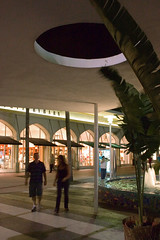
Architecture/Philosophy blog begets Photoblog:
Exquisite Struggle presents FotoFriday
Moonglow Neon and Oculus
Originally uploaded by postmodern sleaze.
Oculus in another shade structure designed by Morris Lapidus on the Lincoln Road Mall
Miami Modern (MiMo)

Architecture/Philosophy blog begets Photoblog:
Exquisite Struggle presents FotoFriday
Miami Modern
Originally uploaded by postmodern sleaze.
One of the shade structures designed by Morris Lapidus on the Lincoln Street Mall (one of the few successful pedestrian malls in America)
Colony Theater and Saxophonist

Architecture/Philosophy blog begets Photoblog:
Exquisite Struggle presents FotoFriday
colony theater and saxophonist
Originally uploaded by postmodern sleaze.
Lone street musician playing under the canopy for the Colony Theater on Lincoln Road
Sterling Building

Architecture/Philosophy blog begets Photoblog:
Exquisite Struggle presents FotoFriday
sterling building
Originally uploaded by postmodern sleaze.
Interesting typology with a Design Within Reach store behind the main block accessible from a sizable courtyard. Nice radiused glass and lighting...
Surfcomber

Architecture/Philosophy blog begets Photoblog:
Exquisite Struggle presents FotoFriday
Surfcomber
Originally uploaded by postmodern sleaze.
The Surfcomber Hotel on Collins. Again lighting works to emphasize the setbacks and horizontal detail of the building.
Miami Beach Skyline
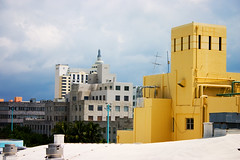
Architecture/Philosophy blog begets Photoblog:
Exquisite Struggle presents FotoFriday
Miami Beach Skyline
Originally uploaded by postmodern sleaze.
Skyline, Miami Beach (Loew's/ The Palms in far background)
Claremont
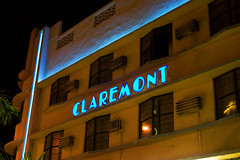
Architecture/Philosophy blog begets Photoblog:
Exquisite Struggle presents FotoFriday
claremont
Originally uploaded by postmodern sleaze.
Artful use of neon to liven up an otherwise bland art deco hotel. Note the art deco-ish a/c unit covers... nice!
Simply Terrifying!
The access panel door on a Diebold AccuVote-TS voting machine — the door that protects the memory card that stores the votes, and is the main barrier to the injection of a virus — can be opened with a standard key that is widely available on the Internet.
...We did a live demo for our Princeton Computer Science colleagues of the vote-stealing software described in our paper and video. Afterward, Chris Tengi, a technical staff member, asked to look at the key that came with the voting machine. He noticed an alphanumeric code printed on the key, and remarked that he had a key at home with the same code on it. The next day he brought in his key and sure enough it opened the voting machine.
This seemed like a freakish coincidence — until we learned how common these keys are.
...A little research revealed that the exact same key is used widely in office furniture, electronic equipment, jukeboxes, and hotel minibars. It’s a standard part, and like most standard parts it’s easily purchased on the Internet. We bought several keys from an office furniture key shop — they open the voting machine too. We ordered another key on eBay from a jukebox supply shop. The keys can be purchased from many online merchants.
Of course the C.E.O. of Diebold lived in a suburb of my hometown and actively campaigned and recruited donors for Bush in 2004 (including writing a letter promising to deliver GOP votes for the president) while simultaneously deploying his flawed machines all over Ohio thanks to an agreement with Ken Blackwell who is now running for governor.
My head hurts...
It's all just a little bit of history repeating

The photo on the left is from the June 06 Martha Stewart Living, on the right is the Baldizzi kitchen as recreated to c.1935 in the Lower East Side Tenement Museum.
The Martha aesthetic rarefies the commonplace and defamiliarizes it. It takes the everyday and makes it exclusive.
This is a poignant example of the capacity of capitalism to subsume anything and everything. As the whirlwind of style continues to accelerate (in part due to manufactured obsolescence and the need to keep fueling consumption in order to stay solvent, let alone turn a profit) everything and anything may be appropriated for unlikely ends. What is surprising is that a brand (like Polo/RL) based so solidly on marketing the fictive lifestyle of landed gentry circa 1920 to suburban cul-de-sacs and double-wides throughout the land would be brash enough to sell the dwindling middle class and the working poor an image of themselves... or rather their forebears. I suppose the convenience imagery of the electric iron and egyptian cotton towels are more than enough to succeed but I really hope this is the over the top result of someone's deliberate sense of irony here. (It seems the design equivalent of a stunt Mr. Cameron Giles might pull.)
I'm resolved to the fact some photo layout designer was low on ideas and dropped by the tenement museum though... oh what a world we live in!
(what is this?): aesthetic laundry: notes
Sayonara Suckers!
The site for our next project is at the end of Lincoln Road, a Morris Lapidus designed pedestrian street in the heart of SoBe. I plan to drop by his legendary Fontainebleau Hotel (beginning setting for Goldfinger)and possibly the Delano (if this silver-toungued blogger can get past the door staff).
Expect results in a future installment of FotoFriday.
Adios...
reawakening: ending dreaming through experience of reality
He continues:
"So, what is the essence of this problem? Is the US legal system so rife with frivolous lawsuits that building codes must comply to ridiculous standards that forsake any possibility of personal responsibility? Is the protection of our populous so important to our policymakers that we must eliminate every possible source of harm? What happened to the America that was wild and exciting, where anyone could strive for their dreams or die trying, where the very real possibility of failure made the win that much richer? How did we become a nation of frightened hermits, isolated in our armored cul-de-sacs and SUVs? What happened to ambition? Where are the foolhardy?
I think the illusion of safety perpetuated by building codes, warning labels, commercial drugs, and the security-obsessed government is killing our national spirit... Despite the state of the middle east, the American people have not been asked to make any sacrifices, and though we are a "nation at war" you certainly can't tell by the home front. Would a "Manhattan"-scale project for sustainable, green power be enough to wean our economy from unstable foreign oil? Perhaps more importantly, who would benefit from such a project?"
I would first like to address the dialectical relationship between control (vis-a-vis safety codification) and responsibility. This happens to be the one point that I can agree on with my friends who also happen to be professed anarchists. While I hold deep reservations (stemming from my Conrad/Golding influenced conception of human nature) about the human repercussions of abandoning codified strictures of behavior, I will readily admit that too much control yields an immature and potentially irresponsible citizen.
The more that the dangers of the world are kept at arm's length, the more people slip into a protracted state of infantilism. This trend has dire repercussions for the future as it has in the past; as Evan alluded, our current war is essentially a war by proxy for there is no reciprocal war on the homefront. Currently in Iraq the proportion of mercenaries to soldiers and official government representatives is 1:6. Not unlike the end centuries of Rome when the legions were staffed with the same barbarians who would shortly sack the eternal city, (their salaries paid by rich senators who disdained the risk of battle) this phenomena will only grow more severe in the coming years. This unfortunately is a self perpetuating cycle; as we continue to wage wars and inflect misery around the globe without any meaningful correlation at home, we, as a population, can easily forget the devastation occurring far away and can become distracted by Bennifer, TomKat or whatever other trifling matter grabs headlines and seizes our collective (un)conscious.
Our utter disconnection and distraction will only serve to get us more embroiled as we fail to fulfill our role by asking difficult questions of our leaders. Furthermore, as other peoples see our inability to concentrate on what our very own government (or elite) is perpetrating, our problems will only worsen. Could it not be argued that the strictures, rules, and codes that protect us ourselves, and by extension, the pain of life can be understood not only to maintain, but to enhance the status quo by allowing us to be distracted by our bread and circuses?
There is a fascinating inversion to the menace of complacency brought about by the metastasizing illusion of safety and all-consuming desire for this chimera that occurs primarily on a subcultural level; as our species has dealt more or less successfully with danger for millennia a need for it has become ingrained in our psyche. Such subcultural phenomena as ultimate fighting or even extreme sports (although at this point their ability to generate profit seems to have made them defacto cultural components of the status quo) exist to fulfill the basic need for danger vis-a-vis the "rush" or adrenaline high generated as a protective impulse due to extreme stress.
In addition to the segment of pure adrenaline junkies there is a large proportion of seemingly rational people who place themselves in harm's way simply for the emotional and mental immediacy generated through such an action. I have heard climbers describe that the joy they get from conquering a vertical cliff face stems from the complete mental focus and utter lucidity they experience as they contemplate where to find safe handholds. I can personally attest that the experience of having to vault off of a impassable catwalk to the flange of a rusted generator thirty feet above the floor in a derelict power station cut like a hot knife through the butter of the fog of everyday life. Before I ramble on for too long I would like to close with a question: if we agree that the unexamined life is not worth living, can we also posit that a life safe from harm and challenge is not a life at all?
I referenced it in the last post, but this is cool!

Commissioned for the 2006 Kwangju Biannale in South Korea, this map traces the myriad threads that link the United States, a myriad of private military contractors (PMC's), and the countries of Columbia and Iraq. (Currently 1 in 6 personnel in Iraq are private contractors) We certainly are living in the age of mercenary war, when
"The coalition of the willing has become the coalition of the billing"
This definitely has serious implications for the future of the Geneva convention as well as the future and viability of State actors in the face of a dominating majority of loyalty-impaired private forces.
Full Image here (50'x9')
via Critical Spatial Practice
The man is on fire!
This time bringing a slice of Gitmo to Disneyland.


From Wooster Collective:
"Families visiting Disneyland on their holiday this week saw a life-size Guantanamo bay inmate standing inside the Rocky Mountain Railroad ride at Disneyland in Anaheim California.
The sculpture, consisting of an inflatable doll dressed in an orange jumpsuit with its hands and feet manacled remained in place for one and a half hours before Disneyland's security staff shut down the ride and removed it amid fears over public safety."
As regular readers know, I'm a strong advocate of Banksy's illicit deployment of art to challenge societal norms and foster social advocacy. It seems he must have been in LA to set up his upcoming secret art show and taken some time off to conflate those caught in the catch 22 of macronational, post-globalized prison camps and the happy spectacle-blinded apathetic citizens who allow the phenomena to persist.
RELATED:

What is it about designers?
Lauren Collins has an interesting article in the upcoming issue of the New Yorker concerning a partnership between the New York School of Visual Arts and the World Monuments Fund to restore a Katrina-ravaged home for a widowed grandmother living on fixed means in Bay St. Louis Mississippi. This idea intrigues me (just as Rural Studio is a continual source of inspiration) as it should help to buttress a design education anchored in the rarefied realm of aesthetics with the practical experience of innovating with limited means, and one hopes, a healthy dose of social concern. While I am the last person to advocate a historicist approach to such a project, it seems preferable to the designs that did emerge:
"Adam Greco, a junior wearing a white leather belt and matching loafers, was first up. Using a PowerPoint slide show, he suggested a kaleidoscopic Clarence House wallpaper (“The swirl kind of really evokes the weather and what you’ve been through”) for the center hall, along with six light fixtures (“Seaglass nods to the beauty of nature’s reclamation”) and, in every room, hurricane lamps..."
"Stephen Honeywell, who in normal circumstances considers himself more of a “high-end residential person” than a preservationist, went next. He apologized for having junked the tête-à-tête chair, but he did suggest that Phillips might want to paint the kitchen seafoam green and install a stainless-steel refrigerator with a built-in TV. “I didn’t even know they had that,” Phillips said."
...you know what I'm not even going to continue; you people fill in the critique.
Weekend News: Banksy takes on Paris Hilton

Lost deep in my slumbers on this last golden three day weekend of summer, (or more actually struggling to come up with a garden design that is radical enough for my aesthetic... ironic that the first landscape project I've ever done is the first project in architecture grad school) I pretty much missed this story when it broke. British graffiti/street art/media jamming superstar BANKSY previously known for his amazing stencil work, illegal art installations in world famous museums, murals on the Israeli Containment Wall, and industrial re-designs has locked his sights on America's
First a quote, then my analysis:
"The secretive artist has smuggled 500 doctored copies of Paris Hilton's debut album into music stores throughout the UK, where they have sold without the shops' knowledge.
In place of Ms Hilton's bubble-gum pop songs, the CDs feature Banksy's own rudimentary compositions. On the cover of the doctored CD, Ms Hilton's dress has been digitally repositioned to reveal her bare breasts; on an inside photo, her head has been replaced with that of her dog. On the back cover, the original song titles have been replaced with a list of questions: "Why am I famous?", "What have I done?" and "What am I for?" Inside the accompanying booklet, a picture of the heiress emerging from a luxury car has been retouched to include a group of homeless people. In another shot, Ms Hilton's head has been superimposed on a shop window mannequin beneath a banner reading: "Thou Shalt Not Worship False Icons."
Instead of Ms Hilton's own compositions, the replacement CD features 40 minutes of a basic rhythm track over which Banksy has dubbed Ms Hilton's catchphrase "That's hot!" and other extracts from her reality TV programme The Simple Life.
--The Independant 03 September 2006
This is a fortuitous confluence for this mild-mannered blogger. Last autumn I actually wrote and presented a paper using Hannah Arendt's The Human Condition as the starting point for a discussion on radical attempts to retake recently privatized realms back to the public sphere. Using concepts dating to Situationist International (derive, detournement, etc...) I exposed such actions as Urban Exploration, Shop-Dropping, and graffiti as inherently public and controversial due to their inherent opposition to a hyper-capitalized, privatized culture.
And what happens?
My example of "post-graffiti radical practitioner" goes and pulls what might be the greatest shop-dropping stunt ever. (Well the Barbie Liberation Organization's operation was pretty sweet too...)
With gleeful abandon Banksy photoshopped a dog onto Paris Hilton's neck (a nice surrealist move if ever there was one) and devised an unforgettable soundtrack (download below). Banksy's questions are blunt, unforgiving, and cut through the simulacra (vapid image of pop stardom rooted in vapid stereotype of spoiled heiress) that is Hilton: Why Am I Famous? What Have I Done? What Am I For? With these three questions Banksy, who has made a career of graphical social activism under illegal to life threatening conditions, challenges not just Ms. Hilton, but her target demographic as a whole to reconnect and involve themselves within the world and focus their illusionary lives around a concrete goal of social justice.
LINK TO IMAGES
LINK TO BANKSY's MUSIC
WATCH BANKSY IN ACTION [YouTube]:
Thor's Hammer

Exquisite Struggle presents FotoFriday
Thor's Hammer
Originally uploaded by postmodern sleaze.
The top of a three story tall generator as seen from catwalk.
(Photo taken from July expedition with Hannah and Rhetoric to CCF)
Space
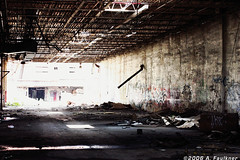
Exquisite Struggle presents FotoFriday
Space
Originally uploaded by postmodern sleaze.
Architecture is Light and Space
(apologies to S. Gideon)
(Photo taken from July expedition with Hannah and Rhetoric to CCF)
Rosette

Exquisite Struggle presents FotoFriday
Rosette
Originally uploaded by postmodern sleaze.
(Photo taken from July expedition with Hannah and Rhetoric to CCF)
Vertigo (mine)
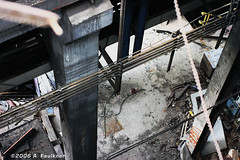
Exquisite Struggle presents FotoFriday
Vertigo (mine)
Originally uploaded by postmodern sleaze.
So this was taken leaning off a rickety catwalk about 50' above the ground... about half the landings were missing, so we had to find alternative ways up... and I was reminded for some reason I'm afraid of heights indoors.
(Photo taken from July expedition with Hannah and Rhetoric to CCF)
Erector Set
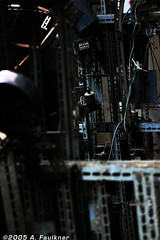
Exquisite Struggle presents FotoFriday
Erector Set
Originally uploaded by postmodern sleaze.
(Photo taken from July expedition with Hannah and Rhetoric to CCF)
Impact
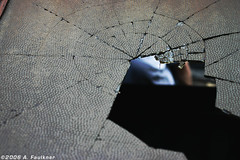
Exquisite Struggle presents FotoFriday
Impact
Originally uploaded by postmodern sleaze.
Looking through a skylight...
(Photo taken from July expedition with Hannah and Rhetoric to CCF)
Detrius
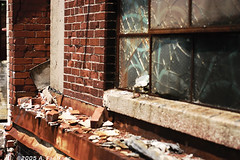
Exquisite Struggle presents FotoFriday
Detrius
Originally uploaded by postmodern sleaze.
(Photo taken from July expedition with Hannah and Rhetoric to CCF)
Charred

Exquisite Struggle presents FotoFriday
Charred
Originally uploaded by postmodern sleaze.
(Photo taken from July expedition with Hannah and Rhetoric to CCF)
The New Cityscape of Fear [via Salon]
" ..you used to be able to walk around Manhattan, both on the sidewalks and through the lobbies of large buildings, without showing any credentials. Today that's nearly impossible because entering nearly every building requires passing through a security checkpoint. The checkpoint culture weighs on the soul, reminding us at every point that we live in a dangerous time, and that anyone we see might seek to do us harm."
Interestingly enough, the article points out that Jersey Barriers are actually the urban structural interventionist equivalent of plastic sheets and duck tape because
"The barriers, which were designed as lane separators by New Jersey's state Highway Authority in 1955, are intended to be placed on roads parallel to the direction in which cars are traveling. A vehicle that nudges too close to the barrier will ride up its tapered edge and slide back onto the road, suffering minimal damage. But placed the opposite way -- in front of a building to protect against oncoming attack -- a Jersey barrier is no match for a fast car or truck. In crash tests, speeding vehicles that hit the barriers at obtuse angles simply knock them over or vault over them straight at the target."
Given this revelation we must stop and consider how many extremely inconvenient security measures are simply in place to convey an appearance of protection, or perhaps more darkly, to circumvent traditional freedoms with greater control. After all, we are currently at war (no, not that one... and that one is technically our weapons, not our war). No the earlier war, the Long War, you know the war against the intangible act? Well, seeing the smashing success we had the LAST time we tried that we should redouble advocacy for intelligent safety solutions rather than half measures that compromise safety through false security while depriving us of the communal life we have more or less enjoyed for 230 years.
On Parks and Public Space [in progress]
Two days ago, as I prepared for my entrance into graduate school, I finished up my advising review and stepped outside. It was an overcast day, but there was a breeze and the temperature was mercifully hovering around 65º as opposed to the eighty degree days with brutal humidity that I have become accustomed to since moving out here. I had a few hours to kill before my next appointment, so I decided to take advantage of my last free day before voluntary M.Arch imprisonment and take a ride through Forest Park.
For those unfamiliar with Forest Park it opened in 1876, and can be seen from a height of 28 miles (thanks GoogleEarth!). A portion of it was borrowed for the 1904 World's Fair (which also included the campus of Washington University and the ever-so-ethnically sensitive named area that would become Dogtown) and, despite incursions and subsequent development of a highway, a surface metro line, a science museum, and a parkway, it still remains 1.4 times bigger than Olmstead's Central Park. I decided to ride the perimeter trail which is about 6 miles in length. After my ride I came to two conclusions: firstly (full disclosure here) I am way out of shape. Recently the sum total of my riding has been more or less to school and back; in my undergrad days that did mean conquering a 8 block long steep hill on the way home (really fun when you haven't slept in 37 hours I can assure you!) but here my route is mostly level unlike the picturesque contours of Forest Park.
The second train of thought is more substantive. Is there anything today that can rival the generosity and public benefit brought about by the parks movement in the late nineteenth century?
Obviously the parks movement has much guilt as a result of its association with the picturesque movement and that movement's subsequent corruption by the Jeffersonian/Lockeian ideal of property ownership and "free market" (I use it in quotes as the American market has never really been free -- look into agriculture subsidies if you disagree) into the unstoppable beast of suburbia. If we can set aside this admittedly culturally influential relationship and examine the unprecedented societal benefits brought about by the parks movement it is almost impossible to compare it to any present day phenomena. To use Forest Park as an example, there are not only typical spaces for recreation, contemplation, and socialization, but also three museums (art, history, and science) and a zoo. Both general museums (such as the Missouri History Museum) and science museums, as well as public zoological parks came out of the late-victorian mania for education and classification; these were modern concepts in the era of the park's inception.
There of course is a darker side and inherent contradiction to this seeming beneficence; these public institutions were created to pacify a somewhat rebellious lower class, to educate the torrent of uneducated European immigrants and indoctrinate them as members of an enlightened American populous, and to preserve the status quo from the feared corrosion of radical European movements (marxism et al) and the homegrown threat of unionization as a result of atrocious conditions. Thus, the parks and other public institutions served to an extent as bread and circuses (or almost the spectacle of Debord) but with the crucial distinction that unlike the carnage of Rome, or the empty spectacle/simulacra of the modern age, such institutions responded to a perceived threat by redirecting society in a positive manner toward greater education for all. If I sound less than radical here it is because the society reacting with positivity is most always preferable to the alternative. It seems that we are now fully in the grasp of the alternative; instead of reacting as those fearful Americans of the late nineteenth century did, we cannot even respond to the perceived threat posed by our on children without resorting to militaristic techniques of control.
At this point it might be a good time to consider the words of one of the most prescient minds of the twentieth century, Walter Benjamin:
"The tradition of the oppressed teaches us that the "state of emergency" in which we live is not the exception but the rule. We must attain to a conception of history that is in keeping with that insight."
-Walter Benjamin
"Theses on the Philosophy of History"
Walter Benjamin: Illuminations, ed. Hannah Arendt (1968)
This militarization and transformation into a society of continuous control has momentous implications for all of the design fields. We, as architects, landscape architects, urban designers, planners, graphic designers, and industrial designers have been given this situation, and we must work constantly and to the best of all our collective abilities to turn these increasingly negative and dangerous responses to the ancient fears of terrorism, cultural difference, political ideology, and race into positive institutions, places, and objects that will contribute meaningfully to the public realm.
Books Cited in this article
The Kids are Alright?? ‘Hanging Out’ as Social Problem [via Spiked]
The Local Government Association (LGA) has compiled a list of naff songs for councils to play in trouble spots in order to keep youths at bay – including Lionel Richie’s ‘Hello’ and St Winifred’s School Choir’s ‘There’s No One Quite Like Grandma’ (1). Apparently the Home Office is monitoring the scheme carefully. This policy has been copied from Sydney, where it is known as the ‘Manilow Method’ (after the king of naff, Barry Manilow), and has precursors in what we might call the ‘Mozart Method’, which was first deployed in Canadian train stations and from 2004 onwards was adopted by British shops (such as Co-op) and train stations (such as Tyne and Wear Metro).
Another new technique for dispersing youths is the Mosquito, a machine that emits a high-pitched noise only audible to teenage ears. Adults walk by unmolested, but youngsters apparently find the device unbearable and can’t stand to be near it for long. The Mosquito, currently being trialled in Somerset, makes a noise that carries over 20 metres or so, and which to adults registers as a kind of faint buzz. To people under 20, however, it can be so piercing that they simply cannot remain in earshot. The Mosquito will literally scream children off the streets (2)....
In 2005, several British towns drafted in the army to patrol the streets at night – a senior Ministry of Defence official said the presence of troops would ‘deter bad behaviour’ from youths. Police in Weston-super-Mare have been shining bright halogen lights from helicopters on to youths gathered in parks and other public places. The light temporarily blinds them, and is intended to ‘move them on’, in the words of one Weston police officer (3).
These bizarre attempts at crowd control provide a snapshot of adult unease about young people. Teenagers are treated almost as another species, immune to reasoning and social sanction. Just as cattle are directed with electric shocks, or cats are put off with pepper dust, so teenagers are prodded with Manilow, Mozart or the Mosquito. ‘Make them go away’ is the only thought here... [emphasis added]
(1) Matthew Norman, London Evening Standard, 12 June 2006
(2) A pain in the ear, Brendan O’Neill, New Statesman, 7 August 2006
(3) A pain in the ear, Brendan O’Neill, New Statesman, 7 August 2006
Confinement, Education and the Control Society [via Ideant]
----
"Perhaps it's not surprising that Foucault, the "panopticon guy", is characterized as a thinker of power, discipline, and punishment. But as Deleuze (1995) points out, Foucault also believed that we are increasingly moving away from being societies based on discipline to societies based on control. According to Deleuze's reading of Foucault: "We're moving toward control societies that no longer operate by confining people but through continuous control and instant communication" (1995, p. 174, my emphasis).
Did Foucault prematurely announce the end of confinement? It sure looks like it when looking at the US, which incarcerates more people than any other country in the world. According to government statistics, the number of people in prison and jail is outpacing the number of inmates released, even while the crime rate continues to fall. By June 2004 there were 2.1 million people in US jails, or one in every 138 residents (ref, ref). Race has everything to do with this issue: "blacks comprise 13 percent of the national population, but 30 percent of people arrested... and 49 percent of those in prison... One in three black men between the ages of 20 and 29 was either in jail or prison, or on parole or probation in 1995." (ref).
And that's just at home. The US is also in the business of confining people abroad. According to the article American Gulag in Harper's Sept. 2006 issue, 450 prisoners are being held at Guantanamo, approximately 13,000 in Iraq, 500 in Afghanistan, and an estimated 100 in secret CIA "black sites" around the world. They have not been formally charged, and have little legal recourse. In essence, they are guilty until the US decides they are innocent. While the man in charge of the facility "firmly believes" that there are no innocent men in Guantanamo, a report based on data from the Dept. of Defense indicates that 55% of the detainees are not determined to have committed any hostile acts against the United States or its allies (ref, ref). According to Harper's, 98 Guantanamo detainees have died to date, it is safe to assume not from natural causes.
But it's not simply the case that this society is a bit behind in the transition from discipline to control. It is actually advancing equally well on both fronts. In fact, increased control goes hand in hand with increased confinement because increased control means more precise ways of identifying those who fail to perform to society's expectations. In a technocracy, control is surveillance: the continuous monitoring of public, private and work life, and the "intelligent" identification of any deviance. But while new control technologies afford more effective and efficient methods of management and surveillance, you still need an apparatus for controlling those who fall outside the established parameters. This group includes those who have failed in the educational system and therefore cannot productively contribute to the service economy, enemies of the state (preemptively defined), non-conforming minorities, etc. (I'm not suggesting there are no criminals in prison; I'm merely drawing some conclusions from trends in the makeup of the prison population). The trick is then to turn the confinement of these 'burdens' of society into a business opportunity by benefiting from their cheap labor or by privatizing the industry of confinement itself (think Halliburton).
I hinted above at the role of education as a control mechanism that helps differentiate the productive members of society from those who should be confined and disciplined. The fact that the same groups who are disproportionately represented in the incarcerated population are also those most likely to drop out of the educational system is not a coincidence (only about half of Black and Hispanic youth graduate with a high-school degree; ref). But for everyone else who succeeds, what does education look like? The answer is: continuous control. I was struck by Deleuze's comments regarding the changing nature of education in a control society:
In disciplinary societies you were always starting all over again (as you went from school to barracks, from barracks to factory), while in control societies you never finish anything... school is replaced by continuing education and exams by continuous assessment. It's the surest way of turning education into a business. (1995, p. 179)
This definitely puts a sinister spin on 'life-long' learning. The constant student is not one who engages in an ongoing perfection of the self, but one who is constantly assessed according to the performance standards of a service economy. Thanks to distance education, e-learning and technologies such as the Learning Management System (LMS), education becomes something that can be delivered anytime and anywhere, and which —more importantly— can be used to monitor performance throughout the 'learning' career of the individual. Thus, assessment-based education helps reconcile control and discipline in society by helping to effect, in the case of those who fail, a transition from controlled subject to disciplined object.
I want to go back briefly to Deleuze's comment about control societies also operating through "instant communication" (1995, p. 174, my emphasis). It would make sense to assume that, in a crude way, control societies would want to control communication. But that is not the case. According to the standard technophile discourse, thanks to technology our societies enjoy an unprecedented freedom of speech and expression. Communication technologies with low operational cost and low barriers of entry (such as blogs) are praised for giving "everyone" a chance to express themselves. But Deleuze points out that "Repressive forces don't stop people expressing themselves but rather force them to express themselves... What we're are plagued by these days isn't any blocking of communication, but pointless statements" (1995, p. 129). Deleuze is suggesting that there is a connection between control and an over-abundance of (meaningless) expression. More of this type of communication has not resulted in stronger social bonds, but in increased isolation: concurrent with advances in ICTs, the last U.S. census shows that 25% of the nation's households (27.2 million) consist of just one person, compared to 10% in 1950 (ref).
This is the paradox of social media that has been bothering me lately: an 'empowering' media that provides increased opportunities for communication, education and online participation, but which at the same time further isolates individuals and aggregates them into masses —more prone to control, and by extension more prone to discipline.
Offline Reference:
Deleuze, G. (1995). Negotiations, 1972-1990. New York: Columbia University Press."
Books cited in this article:


